“The two most beautiful things in the world are
the Taj Mahal and Dolores del Rio.”
– George Bernard Shaw.
But more on her later…
Aurora’s Once Upon A Screen blog is hosting its second annual Hollywood’s Hispanic Heritage Blogathon. And what better way for me to contribute to Hollywood’s Latino history than by talking a little about one of the most beautiful women who ever graced classic films.
I wanted to explore something new and exciting so I checked out the Mexican film noir series held at NYC’s Museum of Modern Art back in July. I saw Dolores Del Rio in “La Otra”. When it started and I saw twin sisters and the giant dog I disappointedly said to myself “Dead Ringer”!!! I was disappointed only b’cuz I knew what was going to happen in this movie as I’d already seen the Bette Davis 1964 film.
Well I was wrong. Dead wrong.
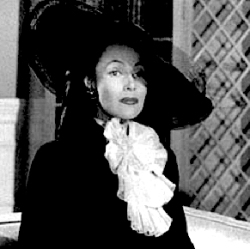
Though both movies share the same plot, “La Otra” ( “The Other One” ) is darker, more intense and more sensual than the 1964-version and that is for one reason and one reason alone: Dolores Del Rio. Del Rio does a good job establishing two distinct personalities in playing twins. Yes, one is good ( María ) and ‘la otra’ is bad ( Magdalena ); but the extra kick is to see María still keep her own persona while impersonating Magdalena. See, it’s not only about being different. It’s what preys on the mind of a good person who does something wrong. Very very wrong.
This is film noir and noir is all about descent. And so…Del Rio descends.

There is something about good María that is ultimately really not so good. She can’t seem to be happy. She can’t seem to be satisfied. She wants. She lacks. There’s an under-lying resentment of what her rich sister possesses, and trust me Magdalena doesn’t make it easy. Her rich husband has just died so she has it all. She flaunts her wealth. The good María has a faithful boyfriend who loves her. But in not recognizing, acknowledging what she has, María throws away all that’s worth having…for money.
Like any good old film noir from the time period, we follow our hapless heroine down a slippery slope of bad decisions paved with guilt and fear. Hell, as soon as she gets into her sister’s rich digs, María gets spooked, scared and pops some Nembutals. ( Guess this murder / identity-stealing thing is not all it’s cracked up to be. ) I love that the plot sticks close to her and doesn’t stray to extraneous characters. We see her machinations of deceipt up close and personal:
- María’s cold-blooded murder,
- forging legal documents in an ingenious way,
- writing out checks like there’s no tomorrow,
- duping people she doesn’t know ( but who knew her sister ).
There’s also the emotional toll all this takes on María that Del Rio delivers equally well.
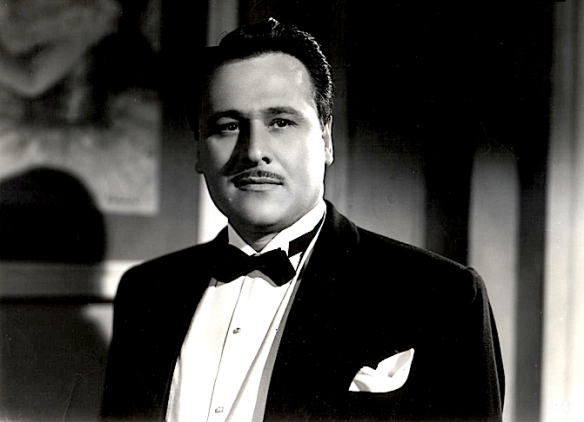
Entering the plot, Magdalena’s lover re-surfaces. Uh-oh. And he’s complicit in having helped Magdalena murder her rich husband. Double uh-oh. And María is aware of NONE of this when she takes over her sister’s identity! ( You can imagine how many UH-0Hs THAT would be ). Now, she may act haughty enough to end the relationship, but ye olde ex-lover Fernando ( played with infuriatingly sleazy smarminess by Víctor Junco ) proffers blackmail…with “benefits.” Poor girl. I don’t what’s worse for María:
- giving up her ill-gotten gains to this blackmailing sleazebag or
- going to bed with this blackmailing sleazebag…a man she doesn’t even know
It’s a cinch our María was a virgin, so this turn of events has got to be a triple whammy of degradation. He doesn’t care if she doesn’t love him. Fernando still gleefully collects his pound of flesh. Aye yi yi, the irony!
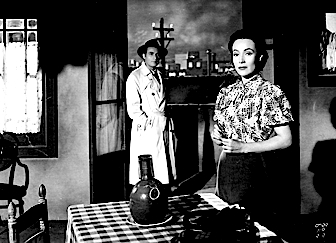
Even more ironic is María’s faithful boyfriend, Detective Robérto Gonzalez ( played with poignant sadness by Agustín Irusta ) sent to investigate María’s ( ‘fake’ ) murder and later, the theft of a valuable painting. Here is the scene that really gets me. In the detective’s consoling and questioning the fake Magdalena, Robérto speaks of his deep love for María. How trippy it is for María to hear herself spoken about in the third person. And trippier still…María as Magdalena speaks of a lost love TO her lost love. Upping the tension, Robérto, even thinks the faux Magdalena SOUNDS like María. But of course that’s impossible, he thinks. I LOVED and felt that daisy chain of incredible regret and heartbreak from both the Detective and María. There’s something epically Shakespearean about unknowingly talking to the person you want to talk to. ( Don’t worry…I won’t bring up “Vertigo” and the duality issue. Sheesh! )
The film uses one unfortunate musical element in its score – the Theremin – which brings to mind 1950’s sci-fi films I love. I knew silly music would set this modern audience off on a tangent of giggles, which I hoped wouldn’t happen. I did hear those slightly annoying giggles for some of the other films to be featured in this festival – you know, when the action would tip the scale into melodramatic territory. But what modern Gringo audiences have to understand, is that besides this film being from another era, the Latin culture has flourishes of emotions and pregnant silences that other cultures don’t quite use; it is a teensy soap opera, but ssssssssssshhhh!


“La Otra” follows Dolores Del Rio closely as her best-laid plans turn to guacamole. She is wonderful in it and is in almost every scene. Her training in silent films helps her wordlessly depict anger, fear, love and regret. The writers ( Robérto Gavaldón, Rian James and José Revueltas ) add some twisty turns as Del Rio spins a web that only entraps her in its matrix. As I watch her in this I’m perplexed as to why she wasn’t really used a lot in 1940’s Hollywood. ( Well yeah, sadly, we all know the major “why” ). But even if she didn’t get those A-list parts Stanwyck and Davis tackled, ( or be in “woman’s pictures” ), she could have still been in the very next tier of talent. She is a perfect actress for the forties. I think Del Rio would have made a marvelous Lady MacBeth; I can see her ambition…being the woman behind the man. And I can definitely see her be the woman who pushes the man…off a cliff. Hollywood should have used her more.
* * * * * * * * * * *
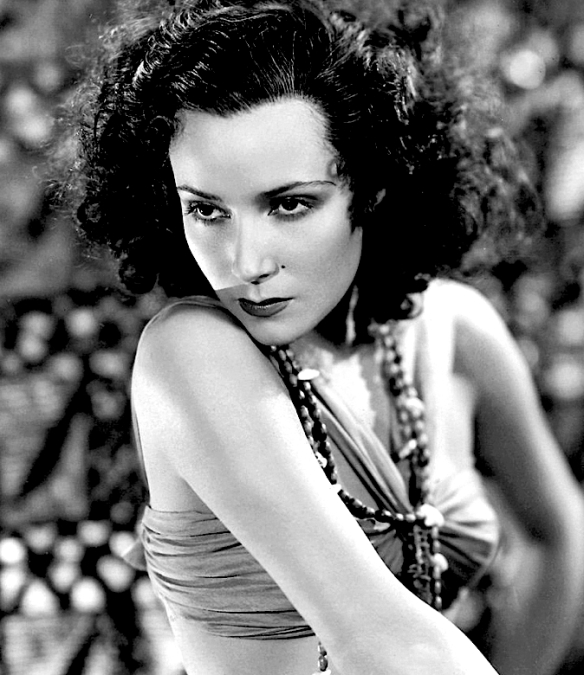
“When I returned to Mexico, I joined with people eager to create the Mexican cinema. We were full of dreams and had no money whatsoever, but we were able to achieve something and open markets for our films all over the world.” – Dolores Del Rio
Forgive me this one minute of gushing before I turn the floor back over to Aurora’s blogathon. Apparently I don’t truly know Del Rio’s career. Surely I know her name, recognize her in photos, and have seen “Flying Down to Rio” “Bird of Paradise” along with bits, pieces and snippets of her other films. I know her but I’m not deeply familiar with her. Imagine the full Monty of sitting in the first row at MoMA, seeing this movie on the big screen and this face appears…in close-up:

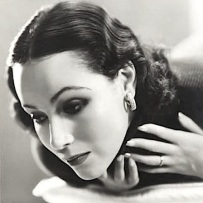

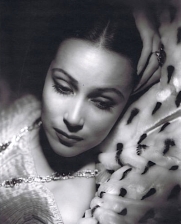

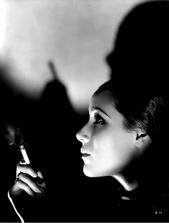
I couldn’t believe it. I was hit for a loop! Those close-ups director Robérto Gavaldón gives Del Rio show a regal ancient flawlessness I’ve never seen in movies, and I’m talking Gene, Hedy, Vivien, Elizabeth, Ava and Jean. And then the mole, just puts everything in high gear. Honestly, I didn’t even understand what I was looking at. I’m going to have to re-read my friend’s, Fernando’s post for last year’s Hollywood’s Hispanic Heritage Blogathon on Dolores Del Rio. You can click the Ramón Novarro banner for more of this year’s crop of posts…or Cesar Romero’s for last year’s as well:
( H O M E )
___________________________________________________________________________

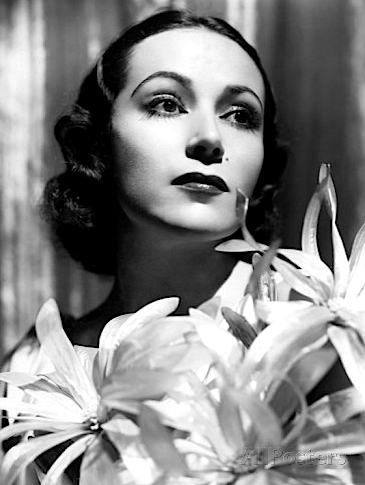

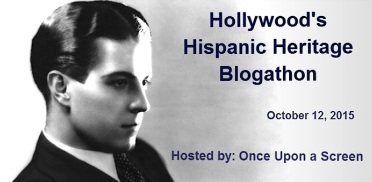
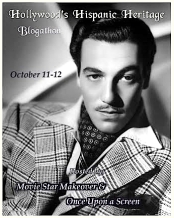
I loved this one, Theresa. I have got to see this movie!
Wanting to contribute a tone of highly esthetic consideration to the conversation, I dug up this quote about Del Rio from Orson Welles, as reported by former Hunter professor Barbara Leaming: “You should have seen her lingerie! he exclaims, four decades later. “Unbelievable! It was all handmade, very hard to find, so erotic it was indescribable!”
LikeLiked by 1 person
L0L! Oh that sets the tone alright. And a mighty high bar, indeed. When I tell you I was knocked for a loop at MoMA, I’m not exaggerating.
Back to her acting, she did a very credible job. The movie was sub-titled and I still got what she was putting across. The bench was pretty crowded in the 40’s with some fine actresses. Del Rio should have had a seat on that bench. She was good and in keeping with what I’ve grown used to seeing of women from that time. You can find “La Otra” on You Tube but it is in Spanish though.
Thanks again Bob.
LikeLike
You’re most welcome, Theresa. You’re right about Hollywood not making the most of Del Rio’s talent and beauty. It may, though, have been her accent which they found limiting. She seems to have had more varied, if still ethnic, roles in silents. I have seen her in the twenties playing French, Spanish (wonderful Carmen!), Russian, Arcadian, and Polynesian (that’s when Orson fell in love with her, aged about eleven). I’ve probably mentioned before that when I very briefly met Raoul Walsh during his series at MOMA in the seventies, he was sitting between Del Rio and Swanson!
LikeLiked by 1 person
Between… Uhhhh, noooo… I…don’t…remember…you…telling…me…that! Whoa! Lucky you, and even luckier Raoul.
LikeLike
Well-written as usual. Thx for showcasing latins. Especially such a gorgeousity like Ms. Del Rio, She was breathtaking. Too bad Hollywood couldn’t envision her as a genuine leading lady for one of their big-budget gringo productions. (I LOVE that photo of her with the wild hair and pearly chest. Dios mio.
LikeLiked by 1 person
Thank you very much Rob.
As far as accents go, I seem to recall Cary Grant had one. Oh, and Errol Flynn. So did Colman, Rathbone, Maureen O’Hara’s soft Irish accent. And didn’t Garbo have an accent in her films? Hmmmm. Well, we all know how Hollywood was. ACK! I’m so glad that Del Rio found another avenue to express her creativity, and elevate the Mexican film industry as well. I love Hollywood, but I know it had its flaws. Thanks for your continued reading. ( Pssst! And if you have a movie that resonates positively with you, I’d love to give you a guest spot on my couch. Just sayin’, man! Just sayin’! )
LikeLike
I know this actress doesn’t quite come close to touching the hem of Del Rio’s beauty, but does anyone remember Rachel Ticotin from “Total Recall”?
LikeLike
This movie AND your commentary, reaction to it are all delicious!! I haven’t seen this in eons, but man did you make me want to run out and get my hands on it. I’m beyond jealous you got to see this on the big screen, but happy you did and shared this fantastic write-up with us all.
Aurora
LikeLiked by 1 person
Hi Aurora. I think with you knowing Spanish, hearing Del Rio, and hearing the Spanish without the middle man ( of subtitles ) would probably make it a real searing visceral experience for you that those of us who don’t know the language will never get. You’d get the full blown passion right there in front of you because there’d be no barrier between you and the actors. I have to say “La Otra” runs rings around “Dead Ringer” and the pathos, the final ending of the movie…whew!
If my essay on this film makes you ( and others ) want to SEE the movie, then YAY!!! I’m head over heels about that!
LikeLike
OH – ALSO – THANK YOU for submitting this to the blogathon! Del Rio is an important part of Hollywood’s Hispanic Heritage and spreading the word about how good Mexican productions are is key.
LikeLiked by 1 person
Thanks for letting my blog join the fun. I’m half-Puerto Rican, so if I can represent…alrighty then! Del Rio IS an important part of the Hispanic legacy for she made many silents. ( See my friend Bob’s comments above. ) Oh she has her place in classics…whether in Hollywood or Mexico. And her beauty…hell…a little part of me thinks there was a jealousy factor on that score too. She truly eclipsed some of the great beauties of 1930’s and 1940’s Hollywood. I wish she’d gotten more of a chance.
Congrats on you going it alone for this year’s Hollywood’s Hispanic Heritage blogathon. And I STILL want to do one with you!
LikeLike
I enjoyed this post from start to finish, and I so want to see this film now! Thanks for all the care and detail you put into it.
LikeLiked by 1 person
Hi! I’m glad you enjoyed this. And listen…if anything, just spending ninety minutes looking at Dolores Del Rio is not bad at all. Thanks for reading and taking the time to comment.
LikeLiked by 1 person
I actually found the film on YouTube and DVD, but no subtitles. Damn my poor Spanish skills. ¡Que lastima!
LikeLiked by 1 person
Oh pobrecito! I know. I saw that. Hope you can find the film. Del Rio is good. I’m half Puerto Rican and know NO Spanish. How shameful is THAT??! Good luck. Seek her out.
LikeLiked by 1 person
Pingback: ¡De Película! Hollywood’s Hispanic Heritage Blogathon | Once upon a screen…
I feel bad about reducing Dolores Del Rio to her physical presence because she was clearly so much more, but she was so incredibly beautiful. I’m still surprised by it, and I’ve seen most of her films.
Enjoyed reading this wonderful review, it’s my favourite Del Rio film and you put your finger on so much of why I like it – the fact that good María is never really that ‘good’, her silent emotion, the slight soap opera vibes… also the costumes which emphasise the character traits so well. This was a delight to read!
But – and they say you learn something every day – I didn’t realise this had been re-made. I’ll just have to watch it to confirm I don’t like it!
LikeLike
Hello there. Thanks for reading and the kind compliment. I haven’t seen enough of Del Rio to have a favorite. But I really like her in this. I like how you laid that out here as well. Double your pleasure…double Del Rio. And speaking of Del Rio’s looks…
I restrained as much as I could to NOT talk about her looks until the end of my piece. Movies is a visual medium. That’s MY alibi and I’m sticking to it. So bring on Dolores. And Errol, and Gable, and Cary, and Tyrone and…
LikeLike
wonderful well done post. Congratulations n taking the leap to explore Del Rio’s Mexican performances. I have always wanted to see her perform in her native language and you article has made this a “must see” for me.
LikeLiked by 1 person
I’m so glad Marsha. Seeing someone speak and emote in their mother tongue is a visceral experience. Even if I didn’t understand…uhmmmm…a word she was saying. Being in silents, she knows how to get emotions across wordlessly. Thank you so much for reading. Yes, “La Otra” IS a MUST.
LikeLike
Great write-up, and not just because you’ve captured this film, but also what makes noir NOIR.
LikeLiked by 1 person
Kelly, I appreciate the compliment. Thanks!!! Oh yeah, Del Rio’s machinations in this one took her to a dark place! And my favorite genre IS film noir as well.
LikeLike
Beautifilly written Tess and great insight on the film, the Era and the actress. I have to see this film.
LikeLiked by 1 person
Thanks so much Fernando. I had to re-read your piece on Del Rio to get the full flavor of her in general. But what I saw up there on the screen…WoW!!! Thanks again for your comments.
LikeLike
Love your writing style! Very dynamic. 🙂 And I like the quote you’ve included at the beginning. I never saw this film, but it seems interesting. The story, about twins, one being good and the other being bad, makes me think of The Dark Mirror (starring Olivia de Havilland). Excellent review. 🙂
LikeLiked by 1 person
Hi Virginie…and thank you!
You’re right about “The Dark Mirror“; and there’s also Bette Davis’ two forays into twindom: “A Stolen Life” and “Dead Ringer“…which got its story from “La Otra” ( which is on YouTube, but alas…in Spanish with NO English subtitles ). Dolores Del Rio did a really good job. And I appreciate your comments.
LikeLiked by 1 person
Pingback: CREPÚSCULO aka TWILIGHT ( 1945 ) | CineMaven's ESSAYS from the COUCH